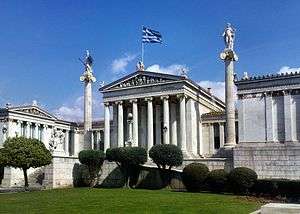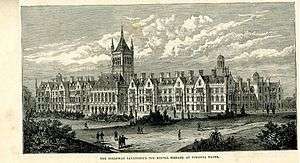1885 in architecture
The year 1885 in architecture involved some significant architectural events and new buildings.
| |||
|---|---|---|---|
|
Buildings and structures
|
Events
- May – The original wooden structures of Hobson Block, West Union, Iowa, USA, are destroyed by fire, leading to construction of the present building.
- W. D. Caröe is appointed architect to the Ecclesiastical Commissioners for England.[1]
- Construction of the Altare della Patria (Monumento Nazionale a Vittorio Emanuele II) in Rome, designed by Giuseppe Sacconi, begins; it will not be completed until 1925.
Buildings and structures
Buildings opened
- July 13 – New building for the Rijksmuseum in Amsterdam, designed by Pierre Cuypers.[2]
- November 30 – London Pavilion variety theatre, designed by Robert Worley and James Ebenezer Saunders.
- December 27 – Church of St. Peter, Leipzig, designed by August Hartel and Constantin Lipsius.
- Castle Hotel, Conwy, Wales.[3]
- Church of Saint Anthony of Padua, Busovača, Bosnia-Herzegovina.[4]
- Vestermarie Church, Bornholm, Denmark.
- Metropole Hotel, London, designed by Francis Fowler and James Ebenezer Saunders.
Buildings completed

The Academy of Athens, Greece
- Autumn – The Home Insurance Building in Chicago, Illinois, designed by William Le Baron Jenney. With ten floors and a fireproof weight-bearing metal frame, it is regarded as the first skyscraper.[5]
- Academy of Athens (Greece), designed by Theophil Hansen in 1859.
- Holloway Sanatorium near Virginia Water in England, designed by William Henry Crossland.
- Sway Tower in Hampshire, England, designed by Andrew Peterson using concrete made with Portland cement. It remains the world's tallest non-reinforced concrete structure.[6][7]
- House for Kate Greenaway, Frognal, London, designed by Richard Norman Shaw.
- Elmside (house), Grange Road, Cambridge, England, designed by Edward Prior.
- Rebuilt Framingham Railroad Station in Framingham, Massachusetts, designed by H. H. Richardson.
Awards
- RIBA Royal Gold Medal – Heinrich Schliemann.
- Grand Prix de Rome, architecture: François Paul André.
Births
- February 23 – Yoshikazu Uchida, Japanese architect and structural engineer (died 1972)
- July 13 – Adolf Behne, German art historian, architectural writer and leader of the Avant Garde movement (died 1948)
- July 15 – Josef Frank, Austrian-born architect and designer (died 1967)
- July 29 – Sigurd Lewerentz, Swedish architect and furniture designer (died 1975)
- August 13 – Charles Howard Crane, American architect (died 1952)
- August 30 – Paul Gösch, German Expressionist artist, architect, lithographer and designer (died 1940)[8][9]
- September 22 – Gunnar Asplund, Swedish "Nordic Classicist" architect (died 1940)
- December 5 – Ernest Cormier, Canadian engineer and architect (died 1980)
- December 17 – Wells Coates, Canadian architect, designer and writer (died 1958)
- December 28 – Vladimir Tatlin, Russian painter and architect (died 1953)[10]
Deaths
- February 1 – Henri Dupuy de Lôme, French naval architect (born 1816)
- March 9 – Matthew Ellison Hadfield, English Victorian Gothic architect (born 1812)
- May 22 – Théodore Ballu, French architect of public buildings (born 1817)
- May 28 – Horace King, US architect, engineer, and bridge builder.[11]
- June 14 – William Tinsley, US-based Irish architect (born 1804)
- August 1 – Thomas Leverton Donaldson, British architect, co-founder and President of the Royal Institute of British Architects[12]
- August 24 – Eduard Riedel, German architect and Bavarian government building officer (born 1813)
- September 2 – Giuseppe Bonavia, Maltese architect (born 1821)
- November 16 – Frederick Ernst Ruffini, US architect (born 1851)
gollark: Also, lol no implicit return.
gollark: That's not very paradoxical, surely? Wouldn't it just return 1?
gollark: Macron cannot be constructed without first having a Macron.
gollark: Macron is in fact provably impossible.
gollark: Denied.
References
- MacAlister, Ian (2004). "Caröe, William Douglas (1857–1938)". Oxford Dictionary of National Biography. Oxford University Press. doi:10.1093/ref:odnb/32298. Retrieved 2012-07-05. (subscription or UK public library membership required)
- "Stadhouderskade 42. Rijksmuseum (1876/85)". Monumenten en Archeologie in Amsterdam. City of Amsterdam. Archived from the original on February 9, 2007. Retrieved 2013-03-24.
- Cadw, "Castle Hotel (3301)", National Historic Assets of Wales, retrieved 11 April 2019
- (in Croatian)http://www.bosnasrebrena.ba/v2010/samostani-i-zupe/samostansko-podrucje-fojnica/busovaca.html Archived 2016-09-15 at the Wayback Machine
- "Home Insurance Building". SkyscraperPage. Archived from the original on 29 June 2011. Retrieved 2011-06-27.
- James, J. (1997). All about Sway Tower. Lymington: Lymington Museum Trust.
- Trout, Edwin (October 2002). "Sway Tower: an early example of high-rise concrete construction". Concrete: 64–5.
- Pehnt, Wolfgang (1973). Expressionist Architecture. Westport, CT: Praeger.
- Selz, Peter (1957). German Expressionist Painting. Berkeley: University of California Press.
- Lynton, Norbert (2009). Tatlin's Tower: Monument to Revolution. New Haven: Yale University Press. p. 1. ISBN 0-300-11130-4.
- Carl Vinson Institute of Government, University of Georgia, Horace King Historical Marker Archived 2008-09-16 at the Wayback Machine, retrieved November 3, 2007.
- Oxford Dictionary of National Biography,Oxford University Press, 2004. Accessed 10 Feb 2014.
This article is issued from Wikipedia. The text is licensed under Creative Commons - Attribution - Sharealike. Additional terms may apply for the media files.
